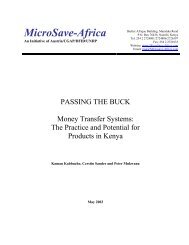You also want an ePaper? Increase the reach of your titles
YUMPU automatically turns print PDFs into web optimized ePapers that Google loves.
Transition<br />
These successes and failures were important<br />
because they highlighted a big and still unanswered<br />
question: what was the future <strong>of</strong> <strong>DAI</strong>’s<br />
own leadership? Through the whole decade, it<br />
was clear that there would be a transition—the<br />
question was when.<br />
Despite some reservations, Mickelwait got the<br />
process under way by beginning to divest his<br />
ownership stake in <strong>DAI</strong>. By 1995, the employee<br />
pr<strong>of</strong>it sharing plan (which had first received<br />
shares in the 1981 cash crisis) and Mickelwait<br />
each owned approximately 37 percent <strong>of</strong><br />
the shares, and other employees owned the<br />
balance, Barclay’s being the largest individual<br />
holding (9 percent). After securing Board approval,<br />
<strong>DAI</strong> hired an attorney to transform the<br />
pr<strong>of</strong>it sharing plan into an Employee Stock<br />
Ownership Plan (ESOP), which then <strong>of</strong>fered <strong>DAI</strong><br />
a tax-advantaged way to buy back shares from<br />
the founder. Mickelwait agreed to sell his shares<br />
over a 12-year period, either to the ESOP or to<br />
other employees who might want to buy them.<br />
The first sale to the ESOP was executed in<br />
1995. Although the Board hoped other employees<br />
would step up and buy some <strong>of</strong> Mickelwait’s<br />
shares, the steady rise in the stock<br />
price—coupled with some uncertainty about the<br />
company’s succession plan—limited demand,<br />
and the ESOP gradually accumulated a larger<br />
and larger share <strong>of</strong> <strong>DAI</strong>’s ownership as Mickelwait’s<br />
declined.<br />
<strong>DAI</strong>’s corporate governance was also undergoing<br />
a sea change. For <strong>years</strong>, the Board had<br />
been mostly amenable to the wishes <strong>of</strong> the CEO<br />
and largest shareholder. There had always been<br />
a few “outside” directors, but up to that time,<br />
most had been elected from the ranks <strong>of</strong> management<br />
and senior staff on a rotating basis. By<br />
1997, however, the <strong>DAI</strong> Board had some strong<br />
and thoughtful independent directors. David<br />
Gunning had been there since the beginning.<br />
After overseeing<br />
nearly a decade <strong>of</strong><br />
tremendous company<br />
growth as President,<br />
Tony Barclay became<br />
<strong>DAI</strong>’s CEO on April 9,<br />
1999.<br />
61



